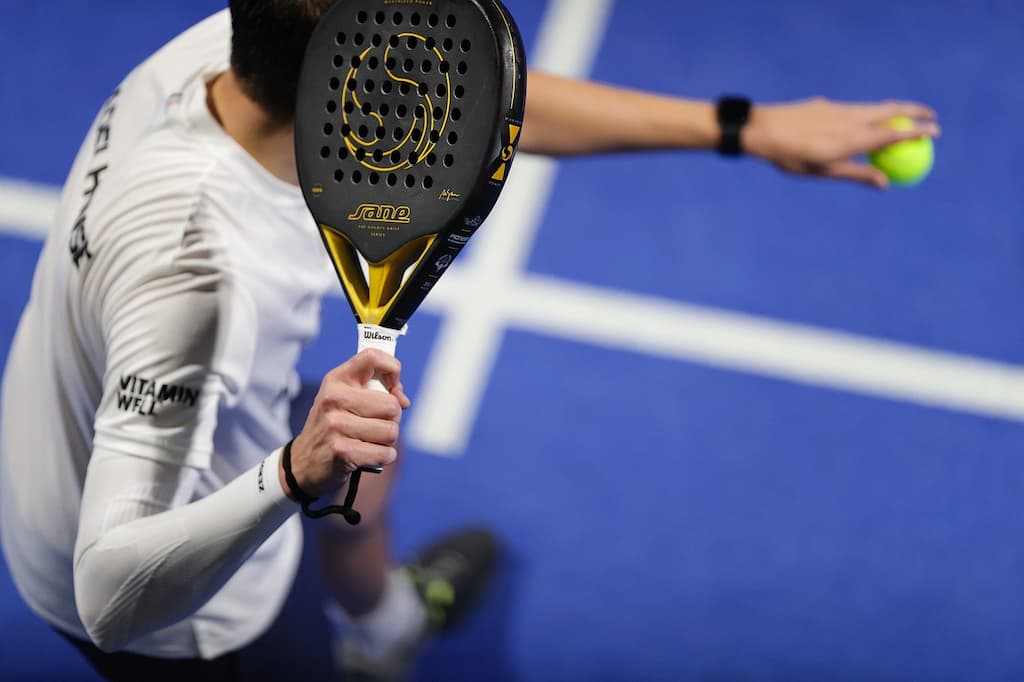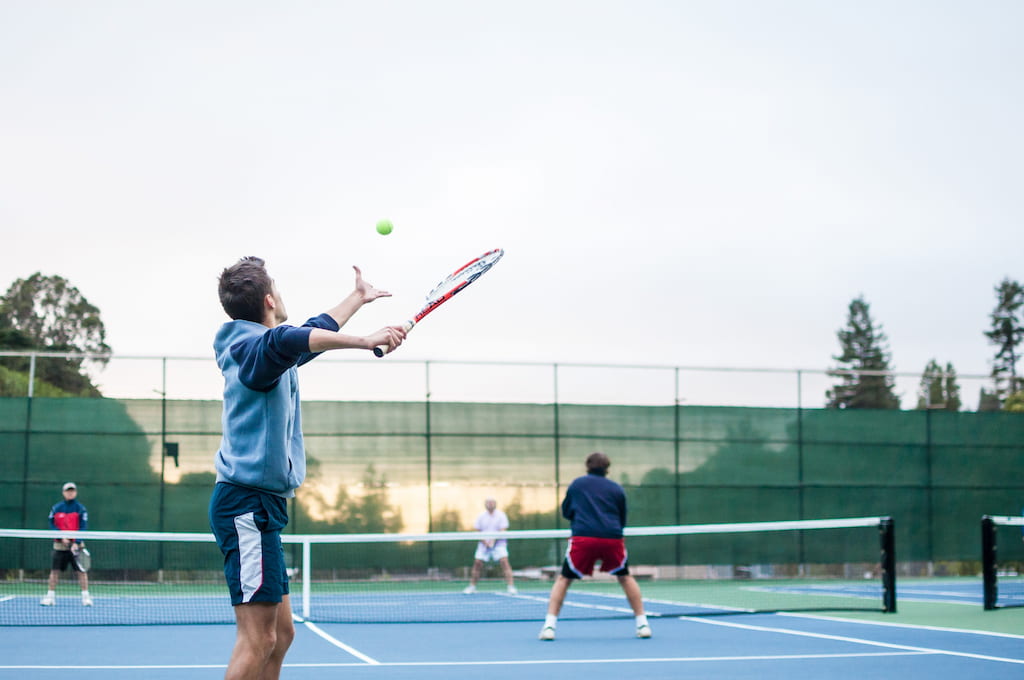Players turn to Padel routines and drills to improve skills like serving at the service line, dominating the baseline game, and executing the forehand volley. These drills, crafted for the Padel court’s unique structure, hone specific techniques like footwork and shots within service boxes. Given the sport’s injury risks, proper warm-ups like the split step, cool-downs, and adequate rest are essential for player safety.
Key Takeaways
- Padel drills focus on enhancing service, baseline play, and volleys.
- Tailored routines help improve footwork and shot techniques on the distinct Padel court.
- Injury prevention, including proper warm-ups and rest, is crucial for players.
Padel Training Routine
A consistent and well-planned training routine is essential for improving one’s overall performance in Padel. A good training routine should focus on developing physical fitness, endurance, reaction time, court positioning, and tactics.
Here’s a balanced training routine for Padel:
Warm-Up (15 minutes)
An effective warm-up is the cornerstone of every successful training session. It not only helps prevent injuries but also ensures that your muscles and joints are ready for the intensity of Padel. By warming up correctly, you lay the groundwork for optimal performance on the court.
Cardio warm-up (5 minutes)
- Jogging around the court or skipping rope.
Dynamic stretching (5 minutes)
- Leg swings
- Arm circles
- Hip circles
- Torso twists
Racquet warm-up (5 minutes)
- Mini-rallies near the net
- Soft volleys
Technical Drills (45 minutes)
Mastering technical skills is crucial for elevating your Padel game. These drills aim to improve your shot accuracy, consistency, and technique, making you a formidable player on the court.
Groundstrokes (15 minutes)
- Forehand and backhand drives against the wall.
- Aim to achieve consistency and depth.
Volleys & bandejas (10 minutes)
- Alternating forehand and backhand volleys.
- Practicing the ‘bandeja’ or overhead shots.
Lobs & smashes (10 minutes)
- Partner feeds a low ball, you lob.
- Partner lobs, you smash or use ‘vibora’ (a type of slice smash).
Service and return (10 minutes)
- Serve to both sides, aiming for consistency.
- Practice return of serves, aiming for depth.
Tactical Drills (30 minutes)
Understanding and practicing game strategies can be the difference between winning and losing. These drills help sharpen your game sense, allowing you to make smarter plays and capitalize on your opponents’ weaknesses.
Positioning and movement (10 minutes)
- Practice quick footwork and positioning with a partner, simulating game situations.
Attack vs. Defense (10 minutes)
- One player near the net, the other at the baseline. Rotate roles.
3-ball sequences (10 minutes)
- e.g., player A serves, player B returns, player A volleys, then rally continues. The goal is to simulate initial match sequences.
Physical Conditioning (20 minutes)
A strong, agile, and endurance-ready body is the foundation of every top Padel player. These exercises will enhance your physical condition, ensuring you remain powerful and nimble throughout the match.
Agility drills (5 minutes)
- Ladder drills, cone drills for quick footwork.
Core strength exercises (5 minutes)
- Planks, Russian twists, and leg raises.
Leg strength exercises (5 minutes)
- Lunges, squats, and box jumps.
Cool down and stretching (5 minutes)
- Static stretches focusing on major muscle groups: hamstrings, quadriceps, calves, shoulders, and back.
Mental Training & Visualization (10 minutes)
The mental aspect of Padel is as important as the physical. Cultivating a strong mindset, visualizing success, and reinforcing positive affirmations can significantly boost your in-game performance and overall confidence.
Breathing exercises (3 minutes)
- Deep breaths in and out, focusing on relaxation.
Visualization (5 minutes)
- Close your eyes and imagine yourself playing a perfect match, executing shots flawlessly.
Positive affirmations (2 minutes)
- Repeat positive statements to yourself like, “I’m improving every day,” “I feel strong and confident,” etc.
By consistently deploying these drills, especially under the guidance of a coaching session, Padel enthusiasts can smoothly sail through the game’s complexities. Regardless of whether you’re a newbie just stepping onto the Padel court or a seasoned pro, persistent practice is your trustworthy ally.
As you engage in groundstroke drills or switch positions during tactical sessions, remember to cherish every learning curve, every stroke, and every game moment. Embrace the Padel journey, refine your prowess, and always remain passionate about the game.
Drills for Padel Training

Padel, a sport that uniquely blends elements of tennis and squash, requires a distinct set of skills and techniques. As with any sport, regular training and practice are essential to mastering these techniques and elevating one’s game.
Specific drills catered to the nuances of Padel can significantly improve a player’s skill set, from ball control and placement to footwork and strategy. Here’s a deep dive into some specialized drills to incorporate into your Padel training routine:
Wall Ball Control
- Description: This drill is instrumental in refining ball control and precision, allowing players to enhance their ability to dictate rallies. It’s especially useful for those looking to improve their ball placement under different court conditions.
- How to do it: Stand facing the glass wall about 2 meters away. Hit the ball against the wall and try to control its return with soft hands, preparing for the next shot.
Side-to-Side Groundstrokes
- Description: Enhancing lateral movement and consistency in groundstrokes can significantly dictate a match’s flow. This drill also aids in boosting a player’s court coverage and shot versatility.
- How to do it: Move from one side of the court to the other, hitting forehands and then backhands. Focus on footwork and shot placement.
Net Play Reflexes
- Description: For players keen on dominating the net, boosting reaction time and sharpening volleying skills are critical. This drill also improves a player’s ability to handle unexpected shots with grace.
- How to do it: Stand close to the net. Have a partner hit fast balls towards you. Try to volley them back quickly, focusing on control.
Defensive Lob Training
- Description: In high-pressure situations, a well-executed defensive lob can turn the tide of a rally. This drill fosters the ability to hit effective lobs, especially when cornered by aggressive opponents.
- How to do it: Start at the baseline. Have a partner or coach pressure you with aggressive shots. Respond with defensive lobs aiming for depth and accuracy.
Service Placement Drills
- Description: A game can pivot on a few crucial serves. Enhancing serve accuracy and consistency can give players a significant edge, ensuring they start rallies on their terms.
- How to do it: Place targets in various service box areas. Serve 10 balls aiming for each target, noting how many times you hit or come close.
Corner Recovery
- Description: Corners can be tricky, and getting trapped can cost points. This drill helps players navigate and extract themselves from tight spots with agility and precision.
- How to do it: Play the ball into the corner and have the player chase and retrieve it, focusing on footwork and quick recovery.
Attack and Defend Scenarios
- Description: Real-game scenarios are unpredictable. This drill helps players acclimatize to rapidly changing dynamics, teaching them when to switch from offense to defense and vice versa.
- How to do it: One player takes the net (attacker) while the other stays back (defender). The attacker tries to finish the point while the defender uses lobs and passing shots.
Mental Endurance Rally
- Description: Beyond physical prowess, Padel demands mental stamina. Long rallies test not just skill but mental grit, and this drill prepares players for such endurance battles.
- How to do it: Engage in rallies aiming for a specific number of shots, e.g., 20 or more. The focus is not on winning the point but on consistency and endurance.
Double’s Communication
- Description: Doubles play hinges on teamwork. This drill emphasizes the importance of seamless communication between partners, ensuring fewer errors and more coordinated plays.
- How to do it: Play points where the goal is to communicate before every shot. Call out who takes the ball and what type of shot to play (e.g., “yours”, “lob”, “down the line”).
Drop Shot Practice
- Description: A well-executed drop shot can catch opponents off-guard. This drill refines touch and finesse near the net, making players more unpredictable and versatile in their game strategy.
- How to do it: From mid-court, practice hitting soft drop shots that just go over the net. Aim for precision and control.
Conclusion
Padel’s dynamic nature requires a dedicated training approach. The right drills can elevate a player’s game, blending technique, strategy, and mental resilience. By integrating these drills, players can navigate the complexities of the sport more effectively. Whether a beginner or a seasoned pro, consistent practice is the key. Embrace the journey, refine your skills, and cherish every moment on the court.
Frequently Asked Questions
What are some effective Padel training exercises?
There are several effective Padel training exercises that can help improve your game. Some of these exercises include practicing your serves and returns, working on your footwork and agility, and practicing your volleys. It is also important to work on your strength and conditioning to improve your overall fitness level.
How can I incorporate cardio into my Padel training routine?
Cardiovascular exercise is an important part of any fitness routine, including Padel training. One way to incorporate cardio into your Padel training routine is to do interval training. This involves alternating between periods of high-intensity exercise and periods of rest. You can also try incorporating cardio exercises such as running, cycling, or jumping jacks into your routine.
What are some advanced Padel drills to improve my game?
If you are looking to take your Padel game to the next level, there are several advanced drills that you can try. One example is the “lob and smash” drill, which involves hitting a high lob and then following it up with a powerful smash. Another advanced drill is the “cross-court volley” drill, which involves hitting volleys back and forth diagonally across the court. It is important to work with a qualified coach or trainer to ensure that you are performing these drills correctly and safely.

